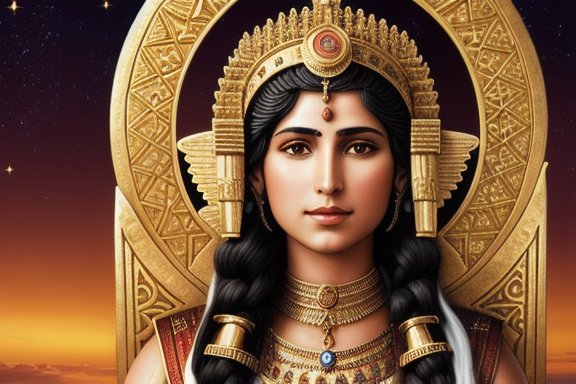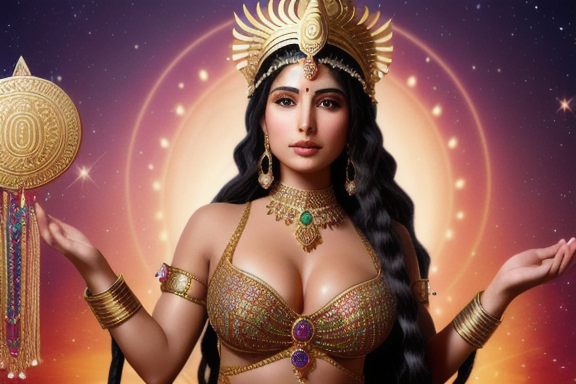The story of Ishtar in the Bible is a fascinating topic that has captivated the interest of scholars and enthusiasts alike. This ancient Mesopotamian goddess has connections to various biblical figures and events, leading to intriguing discussions and interpretations.
One significant connection between Ishtar and the Bible is the parallel between Ishtar’s descent into the underworld and the story of Jesus’ crucifixion and resurrection. Ishtar’s descent was a journey to the realm of the dead to rescue her beloved Tammuz, similar to Jesus’ descent into hell after his crucifixion. This parallel highlights the theme of sacrifice and the triumph over death, which is a central aspect of both narratives.
Furthermore, Ishtar’s association with fertility and sexuality is reflected in biblical passages that mention the worship of fertility goddesses, such as the Queen of Heaven, which some scholars believe to be a reference to Ishtar. This worship involved rituals and practices that were condemned by the prophets, as they saw it as a deviation from the worship of the one true God.

To understand Ishtar’s potential presence in the Bible
It’s essential to explore her role in ancient Mesopotamian mythology. Ishtar was the goddess of love, beauty, and war, and she held great significance in the pantheon of gods in Mesopotamia. Her stories and attributes can provide insights into the potential parallels and influences in biblical narratives.
Ishtar, also known as Inanna in Sumerian mythology, was a complex and multi-faceted deity. She was revered for her beauty and sensuality, and her role as the goddess of love and fertility made her an important figure in Mesopotamian society. Ishtar was believed to bring blessings of abundance and prosperity to the people, and her cult was widespread throughout the region.
However, Ishtar was not just a goddess of love and beauty. She was also associated with war and battle, often depicted armed with a bow and arrow. This duality of her nature, embodying both love and war, reflects the complexities of human existence and the contradictions that exist within the divine realm.
Ishtar’s mythology is rich and full of intriguing stories. One of the most famous tales involving Ishtar is the Descent of Inanna, where she descends into the underworld to confront her sister Ereshkigal. This epic journey is filled with symbolic elements and represents the cyclical nature of life, death, and rebirth. Ishtar’s descent into the underworld and subsequent resurrection can be seen as a precursor to the concept of resurrection in biblical narratives.
Ishtar’s influence can also be seen in the story of the Tower of Babel. In Mesopotamian mythology, Ishtar plays a role in the construction of the tower, which was intended to reach the heavens. The gods, displeased with this act of hubris, confound the languages of the people and scatter them across the earth. This event bears similarities to the biblical story of the Tower of Babel, where God confuses the languages of the people as a punishment for their arrogance.
While Ishtar herself may not be directly mentioned in the Bible, her presence and influence can be seen in various biblical narratives and motifs. The parallels between Ishtar’s stories and biblical accounts provide a fascinating glimpse into the cultural and mythological exchanges that occurred in the ancient Near East.
By delving into the mythology and symbolism surrounding Ishtar, we can gain a deeper understanding of the potential connections between ancient Mesopotamian beliefs and biblical narratives. Exploring these connections allows us to appreciate the rich tapestry of human culture and the diverse influences that have shaped our collective religious and mythological heritage.
Possible Connections to Ishtar in the Bible
While there is no direct mention of Ishtar in the Bible, some scholars have identified potential connections or influences. One such example is the story of the Tower of Babel, where the people aimed to build a tower reaching the heavens. This narrative bears resemblance to the hubris and punishment found in Ishtar’s myth of the Descent to the Underworld.
The story of the Tower of Babel, found in Genesis 11:1-9, recounts how the people of the time decided to build a tower that would reach the heavens, in an attempt to make a name for themselves. This act of defiance and arrogance echoes the myth of Ishtar’s Descent to the Underworld. In Ishtar’s story, she decides to descend into the realm of the dead, defying the natural order and challenging the gods. Both narratives involve a sense of pride and rebellion against divine authority, resulting in consequences for humanity.
Another potential connection can be seen in the biblical figure of Jezebel. Jezebel was a queen of Israel, known for her worship of foreign gods, including Baal and Asherah. Some scholars suggest that Jezebel’s religious practices and association with foreign deities may have been influenced by the presence of Ishtar worship in the region. Ishtar’s prominence in ancient Mesopotamia as a goddess of love and fertility could have potentially influenced other cultures, including the Israelites.
While these connections are speculative and require further examination, they offer intriguing possibilities for exploring the influence of Ishtar in biblical narratives. The presence of similar themes and motifs across different cultures and religions highlights the interconnectedness of ancient civilizations and the shared human experiences that transcend time and geography.

Alternate Interpretations and Counterarguments
It’s important to note that not all scholars agree on the presence or significance of Ishtar in the Bible. Some argue that the similarities between Mesopotamian and biblical narratives are coincidental or influenced by broader cultural themes. Additionally, biblical texts often emphasize monotheism, which may not align with the polytheistic context of Ishtar’s worship.
While some researchers believe that Ishtar’s influence may be found in certain biblical stories, others offer alternative explanations for the similarities. They propose that the shared motifs could be attributed to the cultural exchange and interaction between ancient civilizations rather than direct references to Ishtar. These scholars suggest that Mesopotamian myths and legends may have influenced the development of biblical narratives indirectly.
Furthermore, it is important to consider the theological differences between Mesopotamian and biblical traditions. The Bible portrays Yahweh as the one true God, emphasizing monotheism and discouraging the worship of other deities. This monotheistic perspective contrasts with the polytheistic beliefs associated with Ishtar. Some scholars argue that the absence of explicit references to Ishtar in the Bible is a deliberate choice to distance the Hebrew religious tradition from the worship of other gods and goddesses.
It is also worth noting that the biblical authors may have intentionally modified or reinterpreted existing narratives to fit their theological framework. They could have repurposed certain elements from Mesopotamian myths and legends to convey their own theological messages. This approach allowed them to communicate their beliefs within a familiar cultural context while adapting the narratives to align with their monotheistic worldview.
Conclusion
The question of Ishtar’s presence in the Bible remains a topic of debate and interpretation. While some connections and parallels can be drawn, it is crucial to approach the subject with caution and consider alternative explanations. Exploring the possible influence of ancient Mesopotamian mythology on biblical narratives adds depth and richness to our understanding of both cultures.
It’s important to note that not all scholars agree on the presence or significance of Ishtar in the Bible. Some argue that the similarities between Mesopotamian and biblical narratives are coincidental or influenced by broader cultural themes. Additionally, biblical texts often emphasize monotheism, which may not align with the polytheistic context of Ishtar’s worship.
However, it is worth considering the historical and cultural context in which the Bible was written. The ancient Israelites were exposed to various neighboring cultures, including the Mesopotamians, and it is reasonable to assume that there would have been some cultural exchange and influence. While the biblical texts do not explicitly mention Ishtar by name, there are instances where certain themes and motifs bear resemblance to the goddess and her mythology.
One example is the portrayal of a powerful and influential female figure in the Bible, such as Queen Esther. While not directly linked to Ishtar, Esther’s story shares some similarities with ancient goddess figures, highlighting the importance of powerful women in ancient Near Eastern cultures. This suggests that there may be indirect influences at play.

Furthermore, the presence of fertility and sexual symbolism in certain biblical passages also bears resemblance to Ishtar’s attributes. For instance, the Song of Solomon, known for its passionate and sensual language, can be seen as echoing the themes of love and desire associated with Ishtar.
While these connections may not provide concrete evidence of Ishtar’s direct presence in the Bible, they do highlight the potential influence of ancient Mesopotamian mythology on biblical narratives. It is important to approach these interpretations with an open mind, as they contribute to our broader understanding of the cultural and religious context in which the Bible was written.

Rockin’ the faith, one verse at a time!
Growing up, the Bible’s stories deeply impacted me. Now, with over 15 years of preaching experience, I blend timeless teachings with modern technology, making them relevant for today’s world.
Bible Hub Verse is my platform to share historical insights and thought-provoking articles, exploring both familiar and uncommon Christian topics. My passion is building a welcoming online space for everyone to learn, grow in their faith, and discover the Bible’s enduring message.
Join the journey!
God bless you.








